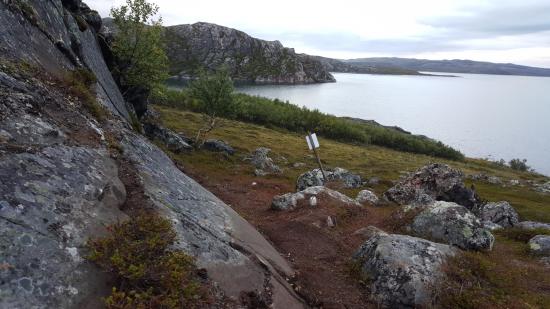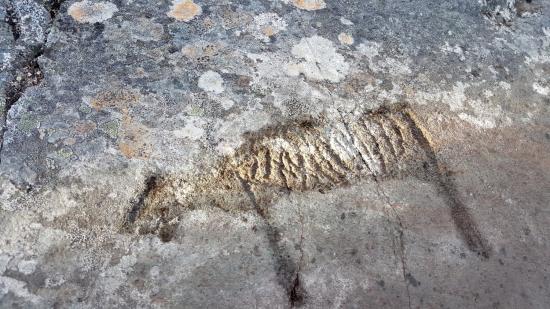Thomas Nilsen
Source - http://barentsobserver.com/en/content/rock-art-sensation-discovered-site-arctic-oil-terminal
Little did Fred Flintstone on the coast of the Barents Sea know about his rock carvings potential trouble-making for a multi-billion oil terminal 7,000 years later in history.
“For most archaeologist, this is not a once in a life-time discovery, it is a never in life-time discovery,” says Anja Roth Niemi when trying to explain the scoop of the rock art on the shores just outside Kirkenes in northern Norway.
 The rock carvings are located inside the industrial area regulated to be an Arctic oil terminal on Norway’s Barents Sea coast. Huge oil tankers can be sailing in and out of Gamnesbukt outside Kirkenes. All carvings are on the rock to the left. Photo: Thomas Nilsen
The rock carvings are located inside the industrial area regulated to be an Arctic oil terminal on Norway’s Barents Sea coast. Huge oil tankers can be sailing in and out of Gamnesbukt outside Kirkenes. All carvings are on the rock to the left. Photo: Thomas Nilsen
Anja Roth Niemi is project manager with the Department of Cultural Sciences at UiT - The Arctic University of Norway. It was her colleague, Erik Kjellman, who first found the Stone Age carvings partly hidden under moss.
“There are both carvings of reindeer and elk. In size between 10 to 40 cm. They are likely made over a period of time, we can see some carvings made over others,” Anja explains with enthusiasm.
 This 7,000 years old rock art reindeer is unique in an archaeological context and the first to be discovered in the Varanger fjord area. Photo: Thomas Nilsen
This 7,000 years old rock art reindeer is unique in an archaeological context and the first to be discovered in the Varanger fjord area. Photo: Thomas Nilsen
The discovery is the first prehistoric art rock made in this area where people started to migrate in after the last Ice Age. “The nearest discoveries of Stone Age carvings are in Porsanger to the west and Kanozero on Russia’s Kola Peninsula to the southeast,” she says.
The team was doing fieldwork at Gamneset, a small headland at a peninsula west of Kirkenes in Finnmark County, where Norterminal is planning for a huge oil-terminal.
By Norwegian law, development plans and construction work cannot start before the site is checked for ancients of the past. If something is found, it is automatically protected until further investigations are made.
The Directorate for Cultural Heritage is responsible for all of Norway’s archaeological monuments.
Isa Trøim is head of section for Archaeology. She says all parties will meet on September 10th to discuss how the discoveries should be managed best. “We have a good cooperation with the developer [of the oil terminal] and the municipality of Sør-Varanger and we hope to find a good solution,” she writes in an e-mail to BarentsObserver.
Anja Roth Niemi explains that the rock in question is located in the middle of the area to be developed in phase 2 and 3 for the planned oil terminal.
“Now, it is important to find out the extent of the rock art. We don’t know how long time that will take,” Anja Roth Niemi says. The rock art with flocks of reindeer and some elks covers an area 15 metres wide and three metres high.
“Maybe people met here and transferred their knowledge, or maybe the carvings were symbols in some beliefs and rituals?” We don’t know, there are many theories,” Roth Niemi elaborates.
The archaeologists have dated the carvings to be between 6,200 and 7,500 years old. The majority of rock art discovered other places are by what at that time was sea level. At Gamnesbukt, the discovery was made on a rock 27 metres above sea level. Geological models made for the Varanger fjord area show a rise of the land over time since the heavy ice melted away placing that rock by sea level some 7,000 years ago.
Maybe Gamneset was a meeting place for Stone Age people from different areas. From Lake Inari in the south, along the rivers Neiden and Pasvik, to the settlements along the Arctic coastline. The Varanger fjord area is by far the area in Norway with most discoveries of Stone Age settlements.
“The rock art gives us unique insights in how people lived those days,” archaeologist Roth Niemi says. She believes it is important to put the findings in a historical perspective.
“The carvings have been here for 7,000 years while an oil terminal will last for some few years.”
...
Little did the Stone Age people know about the Big Oil entering the area around the rock when they made the carvings.
The archaeologists say there could be more ancient reindeer and elk, or even humans, salmon or halibut like in other areas with carvings.
“We are very sure that there are more carvings in the area,” says Anja Roth Niemi.
“The Directorate has asked Tromsø museum to assess further needs for research in the area. As of now, we can therefore not say anything about the scope of any research or time perspective,” says Isa Trøim.
Although, discovered only some few weeks ago, local tourist companies in Kirkenes have already started to cash in on the sensational rock art. For 400 kroner, people can buy a seat on a boat with a guided tour to the rock. The tourist operators hope to copy the success of the rock art in Alta, further west in Finnmark.
Listed on UNESCO’s World Heritage List, Alta has the most famous and largest concentration of rock art in northern Europe, with thousands of visitors annually. For Kirkenes, the question could be: Will it be possible to sell guided tours to a Stone Age rock art site located inside the safety zone of an oil terminal?